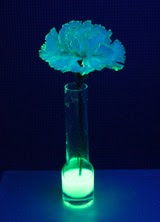The polished facts about nail polish
Women love their makeup, and out of the hundreds of makeup
products, nail polish is on the top five of their list. Nail polish today has
become a significant part of women's fashion and nail care. These small bottles
of coloured nitrocellulose have become a symbol of the 20th century, with more
than half the women using it.
Nail polish is a coloured lacquer applied on toe and fingernails for appearance as well as protection. Nail polish was used in various forms right from the beginnings of civilization, 5000 years ago. The Chinese used a mixture of Arabic gum, egg whites, gelatin and beeswax. Egyptians dipped the tip of their fingers in henna staining their nails a rich dark brown colour and this is still done on festive occasions here in India, especially during marriages.
Chinese royalty used gold and silver to decorate their nails, while Egyptians used nail colour to signify social order with red used by the highest ranks. Queen Cleopatra used a brick red, while Queen Nefertiti preferred a bright ruby, women of lower ranks were permitted to apply only pale hues. Later in the 19th and early 20th century, women polished their nails rather than painting them. But when car paint was invented, it led to the development of coloured nail paint which has a similar composition to that of car paint.
Modern nail polishes are made of nitro cellulose dissolved in a solvent, with other additions such as plasticizers and colouring agents. Nevertheless, some of the chemicals used in nail polish are poisonous and carcinogenic which raises questions about its safety. Nail polish bottles should not be left open as any fumes can be harmful, and it will dry out. Storing nail polish in warm places changes its constitution. So for longer life of nail polish, contrary to popular belief, refrigeration is a good idea.
A normal nail polish has a shelf life of about two years. Comparatively, nail polish removers never expire! Today you get nail polish in normal colours like black, green, pink and you also get diverse and exotic names like ravishing red, passion peach and brave blue, to name a few.
French manicures imitate the natural colour of nails giving a glossy transparent effect using colours such as beige and soft pink. In manicures, nails are painted in four coats of thin layers; this also reduces chipping or bubbling of the polish and gives a smoother effect.
Dark nail polish, if applied very often, leaves yellowish stains on nails which are not harmful but may take a few weeks to go. This can be prevented by first applying a base coat of a lighter colour. Nail polish can also be used as a way of protection for nails, but applying nail polish with hardeners or gelatin does harden nails stopping them from splitting easily. But they also become more stiff and inflexible, breaking under strain.
The origin of nail polish
Nail polish is a coloured lacquer applied on toe and fingernails for appearance as well as protection. Nail polish was used in various forms right from the beginnings of civilization, 5000 years ago. The Chinese used a mixture of Arabic gum, egg whites, gelatin and beeswax. Egyptians dipped the tip of their fingers in henna staining their nails a rich dark brown colour and this is still done on festive occasions here in India, especially during marriages.
Chinese royalty used gold and silver to decorate their nails, while Egyptians used nail colour to signify social order with red used by the highest ranks. Queen Cleopatra used a brick red, while Queen Nefertiti preferred a bright ruby, women of lower ranks were permitted to apply only pale hues. Later in the 19th and early 20th century, women polished their nails rather than painting them. But when car paint was invented, it led to the development of coloured nail paint which has a similar composition to that of car paint.
What nail polish is made of
Modern nail polishes are made of nitro cellulose dissolved in a solvent, with other additions such as plasticizers and colouring agents. Nevertheless, some of the chemicals used in nail polish are poisonous and carcinogenic which raises questions about its safety. Nail polish bottles should not be left open as any fumes can be harmful, and it will dry out. Storing nail polish in warm places changes its constitution. So for longer life of nail polish, contrary to popular belief, refrigeration is a good idea.
Storing nail polish in warm places changes its constitution. So for longer life of nail polish, contrary to popular belief, refrigeration is a good idea.
A normal nail polish has a shelf life of about two years. Comparatively, nail polish removers never expire! Today you get nail polish in normal colours like black, green, pink and you also get diverse and exotic names like ravishing red, passion peach and brave blue, to name a few.
What is a French Manicure?
French manicures imitate the natural colour of nails giving a glossy transparent effect using colours such as beige and soft pink. In manicures, nails are painted in four coats of thin layers; this also reduces chipping or bubbling of the polish and gives a smoother effect.
Is nail polish harmful in any way?
Dark nail polish, if applied very often, leaves yellowish stains on nails which are not harmful but may take a few weeks to go. This can be prevented by first applying a base coat of a lighter colour. Nail polish can also be used as a way of protection for nails, but applying nail polish with hardeners or gelatin does harden nails stopping them from splitting easily. But they also become more stiff and inflexible, breaking under strain.


Comments
Post a Comment